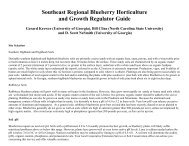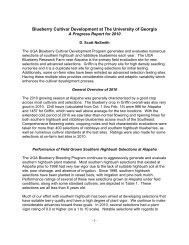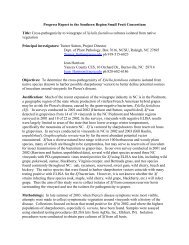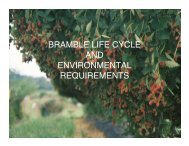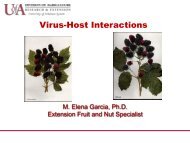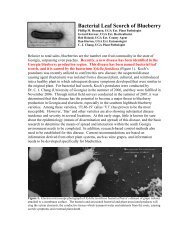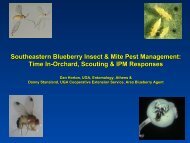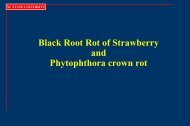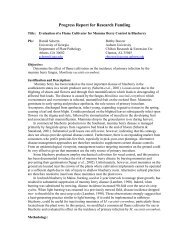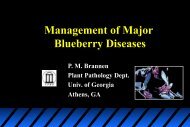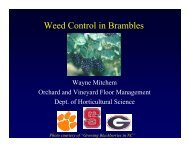Southeast Regional Muscadine Grape Integrated Management Guide
Southeast Regional Muscadine Grape Integrated Management Guide
Southeast Regional Muscadine Grape Integrated Management Guide
Create successful ePaper yourself
Turn your PDF publications into a flip-book with our unique Google optimized e-Paper software.
<strong>Southeast</strong> <strong>Regional</strong> <strong>Muscadine</strong> <strong>Grape</strong> <strong>Integrated</strong> <strong>Management</strong> <strong>Guide</strong>Commodity EditorBill Cline (North Carolina State University)Section EditorsPathology; Bill Cline (North Carolina State University)Entomology; Dan Horton (University of Georgia) and Frank Hale (University of Tennessee)Weed Science; Wayne Mitchem and David Monks (North Carolina State University)Vertebrate <strong>Management</strong>; David Lockwood (University of Tennessee)<strong>Grape</strong> Culture; Barclay Poling (North Carolina State University) and Gerard Krewer (University of Georgia)Pesticide Stewardship and Safety; Bob Bellinger (Clemson University)and Paul Guillebeau (University of Georgia)Senior EditorsPhil Brannen (University of Georgia)Powell Smith (Clemson University)Contributions were also made by Allen Straw (Virginia Polytechnic Institute and State University).Recommendations are based on information from the manufacturer’s label and performance data from research and extension field tests.Because environmental conditions and grower application methods vary widely, suggested use does not imply that performance of the pesticide willalways conform to the safety and pest control standards indicated by experimental data.This publication is intended for use only as a guide. Specific rates and application methods are on the pesticide label, and these are subjectto change at any time. Always refer to and read the pesticide label before making any application! The pesticide label supercedes any informationcontained in this guide, and it is the legal document referenced for application standards.
<strong>Muscadine</strong> <strong>Grape</strong> <strong>Integrated</strong> <strong>Management</strong> <strong>Guide</strong>DormantWinter pruning – Proper pruning aids in disease management. Hedge or hand prune vines, leaving only 3-4” stubs (spurs) of 1-yr-old wood protruding fromthe main cordon or previous season’s wood. Selectively thin these spurs or spur clusters to space them approximately 4-6” along the cordon. As the vines age ,remove some of the older spur clusters when crowding occurs. Young vines (1-4 yrs old) require special attention to remove grape tendrils that wrap around thenew cordon. If not removed, these tendrils will girdle and kill the newly-trained arm. After the 3 rd or 4 th year, the cordon becomes too thick for tendrils to wraparound it, and this girdling ceases to be a threat. Late winter is the best time to prune muscadines in areas subject to winter injury.Amount ofFormulation Effectiveness(+) orper acre Importance(*) REI PHI Comments and PrecautionsPest/ProblemRots and foliagediseases<strong>Management</strong>OptionsSanitation andpruning*** Control weeds under vines with chemicals ormowing; trim vines if needed, so shoots terminateat least 18-24” from the ground. This willpromote air movement and drying under vines.Prebloom (Bud break till bloom)Angular leafspot – (Mycosphaerella angulata) has great potential to limit yield. It causes leaf spotting that leads to rapid defoliation. When a muscadine vinedefoliates prior to harvest, development of fruit ceases. Total crop loss may occur. Fortunately, angular leafspot is easy to control with either mancozeb orcaptan. In wet seasons, however, control may be expensive due to the need for repeated fungicide applications.Dieback “dead arm” diseases – Fungal dieback diseases (caused by Botryosphaeria, Phomopsis, Fusicoccum, etc.) can quickly kill even mature plants. Thesediseases are often observed on plants as they come out of dormancy or following initial fruit swell. Symptoms are observed as a rapid death of the plant fromthe growing cordon tips back towards the main trunk. The disease organisms which cause these dieback diseases reside in pruning or other wounds, and they aregenerally present on all muscadines. Plant stress triggers the reaction which allows the disease organisms to further invade and kill a plant. Any actions whichreduce plant stress throughout the year will be helpful (irrigation, proper fertilization, etc.). Cold injury may also trigger these “dead arm” diseases by causingwounds to trunks and cordons. Spraying with fungicides immediately following each day of pruning may possibly help to reduce the ingress of the pathogens inpruning wounds (recommended for bunch grapes), but there is not enough information available to determine whether this works well for muscadines. If adieback disease is observed, the cordon must be severed at least 6” below the area of dead and dying tissue. Severe pruning (to the trunk; a few inches aboveground level) is sometimes necessary, in which case, new growth will have to be trained to re-establish the vine on the trellis.Aphids in muscadines are typically cool-season, spring pests. Natural enemies often moderate aphid numbers as the weather warms. Treat if aphids are abundantand new shoot tips or foliage are becoming malformed.Leafhoppers are sucking pests that may be very abundant. Leafhopper injury is seen as colorless, cleared stippling on leaves; heavy infestations can causedefoliation. Leafhoppers may be present through much of the growing season, but often in numbers that appear to do no harm. Provisional treatment thresholdssuggest treating for 10 leafhopper nymphs or adults per leaf, or when leafhoppers and injury are seen (stippling and weak, unthrifty growth).Flea beetles are foliage feeders that eat holes in the leaves. Less than 10% foliar injury is unlikely to be harmful. Treat if flea beetles are abundant and injury isevident.1
Prebloom (Bud break till bloom) continuedPest/ProblemBlack rotBitter rotAngular leaf spotPowdery mildew<strong>Management</strong>Optionsmyclobutanil(Nova 40W)thiophanate-methyl(Topsin M 70WSB)azoxystrobin(Abound 2.08SC)trifloxystrobin(Flint 50WG)pyraclostrobin +boscalid(Pristine WG)kresoxim-methyl(Sovran 50 WG)Amount ofFormulationper acreEffectiveness(+) orImportance(*) REI PHI Comments and Precautions3-5 oz ++++ 24 hrs 14 days Do not apply more than 1.5 lb of Nova 40W peracre per year. Interval for repeat applicationsshould not exceed 14 days.1-1.5 lb +++ 7 days 14 days Apply when foliage first develops and repeat at 14to 21 day intervals or as needed. Do not applymore than 4 lb. product (2.8 lb ai)/acre/season.Use only in combination or alternation with alabeled non-benzimidazole fungicide.11-15.4 fl oz +++++ 4 hrs 14 days Do not make more than four applications ofAbound per acre per year. Do not apply morethan 2 sequential sprays of Abound. Alternateapplications with other fungicides which have adifferent mode of action.2 oz +++++ 12 hrs 14 days Do not apply more than 8 oz Flint per acre perseason. Do not make more than 4 applications ofFlint per season. Do not apply more than twoapplications of Flint before switching to a nonstrobilurinfungicide.8-10.5 oz +++++ 24 hrs 14 days Do not make more than five applications ofPristine or related fungicides (strobilurin orcarboxamide) per season. Do not make more thantwo sequential applications before alternating witha fungicide with a different mode of action.3.2-4.8 oz ++++ 12 hrs 14 days Do not make more than four applications ofSovran per acre per year. Do not apply more than2 sequential sprays of Sovran. Alternateapplications with other fungicides which have adifferent mode of action.Do not apply more than 24 lb of Dithane M45,Manzate 200DF, Maneb 80WP or Penncozeb75DF per acre per season. Repeat applications at7 to 10 day intervals.Dithane M45 2-3 lb +++ 24 hrs 66 daysManzate 75DF 1.5-4 lb +++ 24 hrs 66 daysManeb 75WP 1.5-4 lb +++ 24 hrs 66 daysPenncozeb 75DF 1.5-4 lb +++ 24hrs 66 days2
Pest/Problem(continued)Black rotBitter rotAngular leaf spotONLYPowdery mildewBlack rot ONLY<strong>Management</strong>OptionsAmount ofFormulationper acreEffectiveness(+) orImportance(*) REI PHI Comments and PrecautionsZiram 76 DF 3-4 lb +++ 48 hrs 21 dayscaptan(Captan 50WP)captan(Captec 4L)4 lb +++ 72 hrs 0 day2 qt +++ 72 hrs 0 dayRepeat Captan applications at 7 to 14 dayintervals.Bayleton 50DF 2-6 oz +++ 12 hrs 14 days Do not apply more than 18 oz. of Bayleton 50DFper acre per year. Repeat applications at 7 to 14day intervals. Does not control ripe rot orMacrophoma rot.Powdery mildewONLYwettable sulfur(Microthiol, variousbrands, 80 to 92% S)3-10 lb ++++ 24 hrs -- Must be applied every 7-10 days. Dilute sulfur in100 gal of water per acre. Sulfur is corrosive tosprayers and trellis wires.Aphid malathion 57EC 1.5 pt ++++ 12 hrs 3 days Treat if aphids are abundant and terminals orfoliage are becoming malformed.Leafhoppers malathion 57EC 1.5 pt ++++ 12 hrs 3 daysFlea beetlescarbaryl(Sevin 80WSP)1.25 to 2.5 lb +++ 12 hrs 7 daysphosmet 1.33-2.125 lb ++++ 14 days 14 days(Imidan 70W)fenpropathrin(Danitol 2.4EC)5 - 10 fl oz +++ 24 hrs 21 dayscarbaryl 1.25 to 2.5 lb ++++ 12 hrs 7 days(Sevin 80WSP)Malathion 57EC 1.5 pt +++ 12 hrs 3 daysLeafhopper injury is seen as colorless, clearedstippling on leaves; heavy infestations can causedefoliation. Provisional treatment thresholdssuggest treating for 10 leafhopper nymphs oradults per leaf or when leafhoppers and injury areevident (weak, unthrifty growth.)Flea beetles chew holes in the foliage. Less than10% foliar injury is unlikely to be harmful. Treatif flea beetles are abundant and injury is evident.phosmet(Imidan 70W)1.33-2.125 lb ++++ 14 days 14 days3
Pest/ProblemFlea beetles<strong>Management</strong>Optionscarbaryl(Sevin 80WSP)Amount ofFormulation Effectiveness(+) orper acre1.25-2.5 lbs ++++ 12 hrs 7 daysImportance(*) REI PHI Comments and Precautionsmalathion 57EC 1.5 pt +++ 12 hrs 3 daysphosmet(Imidan 70W)1.33-2.125 lb ++++ 14 days 14 daysFlea beetles are foliage feeders that eat holes inthe foliage. Less than 10% foliar injury is unlikelyto be harmful. Treat if flea beetles are abundantand injury is evident.Black rotBitter rotAngular leaf spotPowdery mildewmyclobutanil(Nova 40W)thiophanate-methyl(Topsin M 70WSB)azoxystrobin(Abound 2.08SC)trifloxystrobin(Flint 50WG)pyraclostrobin +boscalid(Pristine WG)kresoxim-methyl(Sovran 50 WG)3-5 oz ++++ 24 hrs 14 days Do not apply more than 1.5 lbs of Nova 40W peracre per year. Interval for repeat applicationsshould not exceed 14 days.1-1.5 lb +++ 7 days 14 days Apply when foliage first develops and repeat at 14to 21 day intervals or as needed. Do not applymore than 4 lb. product (2.8 lb. ai)/acre/season.Use only in combination or in an alternatingapplication program with a labeled nonbenzimidazolefungicide.11-15.4 fl oz +++++ 4 hrs 14 days Do not make more than four applications ofAbound per acre per year. Do not apply morethan 2 sequential sprays of Abound. Alternateapplications with other fungicides which have adifferent mode of action.2 oz +++++ 12 hrs 14 days Do not apply more than 8 oz Flint per acre perseason. Do not make more than 4 applications ofFlint per season. Do not apply more than twoapplications of Flint before switching to a nonstrobilurinfungicide.8-10.5 oz +++++ 24 hrs 14 days Do not make more than five applications ofPristine or related fungicides (strobilurin orcarboxamide) per season. Do not make more thantwo sequential applications of Pristine beforealternating with a fungicide with a different modeof action (neither strobilurin or carboxamide).3.2-4.8 oz ++++ 12 hrs 14 days Do not make more than four applications ofSovran per acre per year. Do not apply more than2 sequential sprays of Sovran. Alternateapplications with other fungicides which have adifferent mode of action.6
Pest/ProblemBlack rotBitter rotAngular leaf spotONLY<strong>Management</strong>OptionsAmount ofFormulationper acreEffectiveness(+) orImportance(*) REI PHI Comments and PrecautionsDithane M45 2-3 lb +++ 24 hrs 66 days Do not apply more than 24 lb Dithane M45,Manzate 200DF 1.5-4 lb +++ 24 hrs 66 daysManzate 200DF, Maneb 80WP or Penncozeb75DF per acre per season. Repeat applications atManeb 80WP 1.5-4 lb +++ 24 hrs 66 days 7 to 10 day intervals.Penncozeb 75DF 1.5-4 lb +++ 24 hrs 66 daysZiram 76 DF 3-4 lb +++ 48 hrs 21 daysPowdery mildew,Black rot ONLYPowdery mildewONLYSooty blotch(‘Fry’ variety)captan(Captan 50WP)4 lb +++ 72 hrs 0 day* Repeat Captan applications at 7 to 14 dayintervals. Label allows application up to day ofcaptan2 qt +++ 72 hrs 0 day* harvest; however; note 3-day re-entry interval.(Captec 4L)Bayleton 50DF 2-6 oz 12 hrs 14 days Do not apply more than 18 oz. of Bayleton 50DFper acre per year. Repeat applications at 7 to 14day intervals. Does not control ripe rot orMacrophoma rot.wettable sulfur(various brands, 80 to92% S)captan(Captan 50WP)captan(Captec 4L)azoxystrobin(Abound 2.08SC)trifloxystrobin (Flint50WG)2-5 lbs ++++ 24 hrs -- Must be applied every 7-10 days. Dilute sulfur in100 gal of water per acre. Sulfur is corrosive tosprayers and trellis wires.2.0-4.0 lb +++ 72 hrs 0 days*2.0 qt +++ 72 hrs 0 days**Label allows application up to day of harvest;however; note 3-day re-entry interval11.0-15.4 fl oz +++++ 4 hrs 14 days Do not make more than four applications ofAbound per acre per year. Do not apply morethan 2 sequential sprays of Abound. Alternateapplications with other fungicides which have adifferent mode of action.2.0 oz +++++ 12 hrs 14 days Do not apply more than 8 oz Flint per acre perseason. Do not make more than 4 applications ofFlint per season. Do not apply more than twoapplications of Flint before switching to a nonstrobilurinfungicide.7
Pest/Problem<strong>Management</strong>Optionspyraclostrobin +boscalid (Pristine)Amount ofFormulationper acreEffectiveness(+) orImportance(*) REI PHI Comments and Precautions8.0-10.5 oz +++++ 24 hrs 14 days Do not make more than five applications ofPristine or related fungicides (strobilurin orcarboxamide) per season. Do not make more thantwo sequential applications of Pristine beforealternating with a fungicide with a different modeof action (neither strobilurin or carboxamide).Summer cover (post-bloom) sprays until harvestFruit rots: Bitter rot and black rot – These rots are usually controlled by fungicide applications pre-bloom to first cover. Proper pruning and removal ofinfected berries, leaves and old fruit stems from the previous winter may reduce disease. If bitter rot is very heavy, fungicides can be applied at shootemergence, 3-5 inches, 8-10 inches and at 7-10 day intervals until fruit set. Black rot-susceptible varieties can be sprayed with fungicide every 14 days from thestart of new growth until after bloom. Black rot control is particularly needed on highly susceptible cultivars such as Carlos and Cowart. Ripe rot – Ripe rotcan be particularly severe on susceptible cultivars such as Higgins, Magnolia, Summit, Watergate, Carlos, Fry, Dixieland, and Scuppernong. Sooty blotchcauses a dark, superficial discoloration on the surface of otherwise healthy fruit; the disease is common on the cultivar Fry. Macrophoma rot – This can alsobe a major rot problem, control can be improved with early cover sprays of Captan, particularly on susceptible cultivars such as Chowan, Higgins, and Fry.Cover spray insecticides are applied at first, second and third cover, and 14-days pre-harvest. Growers who do not apply cover sprays and rely solely on “asneeded”applications should scout frequently for insect damage, including detailed plant examination for insect or mite pests.<strong>Grape</strong> berry moth is somewhat sporadic, but if present can be very damaging. This moth has several generations per season, beginning around bloom. Inmuscadines, grape berry moth is normally a mid- to late-season pest. Eggs are laid on the berry clusters, and young larvae enter berries at the stem end; theirfeeding, webbing and frass can damage multiple berries within a cluster. Spray promptly if infested clusters are seen or if a vineyard has a history of grape berrymoth infestations.<strong>Grape</strong> curculio is a small weevil (snout beetle) that typically emerges in mid-June (in GA). <strong>Grape</strong> curculio initially feeds on the underside of leaves in ashallow zigzag pattern before beginning to lay eggs in the berries. Spray if grape curculio are present or if either foliar or fruit injury are seen. This is a sporadicpest that is sometimes a problem in unmanaged vineyards where weeds and wild hosts thrive.Green June beetle and Japanese beetle populations can get out of hand rapidly. Moderate defoliation is seldom damaging. Fruit feeding is serious, so do notallow these pests to feed heavily on and become abundant in blocks with ripe fruit. Beware of heavy emergence and migration to blocks with ripe fruit afterrains. Multiple applications are often necessary to maintain control if populations are allowed to build up. Ripening fruit and aggregation pheromone mayquickly attract ‘new’ beetles to your vineyard after successful applications.Wasps,hornets, yellowjackets and imported fire ants may be attracted to ripening fruit. Feeding injury or the presence of insect debris in harvested fruit canbe damaging, and stinging insects discourage pick-your-own customers. Pre-harvest insecticide options are limited; monitor and treat only as needed.Spider mites and others – Mites are capable of explosive population growth. Treat if more than 10 mites per leaf are found or if mites are present and leavesare webbed or bronzed. Drought and heavy crop load aggravate mite injury, especially early in a growing season. Two treatments at 1 week intervals may beneeded. Brevipalpid mites (flat mites) cause russeting around leaf veins and at the stem end of berries in NC, and this mite may occasionally warrant control.8
Pest/ProblemBlack rotBitter rotRipe rotMacrophoma rotAngular leaf spotSooty blotch<strong>Grape</strong> berry moth<strong>Grape</strong> curculioJapanese beetlesGreen June beetlesStink bugsSpider mites<strong>Management</strong>OptionsSame as sprays forFirst CoverPhosmet(Imidan 70W)fenpropathrin(Danitol 2.4EC)Fenbutatin-oxide(Vendex 50WP)dicofol(Kelthane 50WP)pyridaben(Pyramite 0.6 WSBorNexter 75WP)bifenazate(Acaramite 50WS)abamectin(Agri-Mek 0.15 ECorAbba 0.15 EC)fenpropathrin(Danitol 2.4EC)fenpyroximate(FujiMite 5EC)Amount ofFormulationper acreEffectiveness(+) orImportance(*) REI PHI Comments and PrecautionsManzate products can only be used in early seasonapplications. These products are very effective,but do not exceed the 66 day preharvest interval.Other effective cover sprays should include tankmixes of Topsin M or Nova with Captan orCaptec, OR alternate Topsin M or Nova withAbound, Pristine or Flint.1.33-2.125 lb +++++ 14 days 14 days Imidan seldom prompt outbreaks of secondarypests such as mites, and is less toxic to workersthan azinphos methyl.10-21 fl oz +++++ 24 hrs 21 days Danitol is effective against a broad array of insectsand is an acceptable miticide. Danitol is thematerial of choice for stink bugs. Danitol is apyrethroid, its use may prompt rebound of mitenumbers later in the season.1 lb +++ 48 hrs 28 days Do not retreat with Vendex for 21 days.1-2 lb +++ 48 hrs 7 days4.4 oz++++ 12 hrs 7 days Pyramite/Nexter is an excellent miticide forEuropean red mite.0.75-1 lb +++++ 12 hrs to5 days14 days Acaramite provides excellent twospotted spidermite control.6 – 16 fl oz +++++ 12 hrs 28 days Abamectin products are long residual miticides.They should be applied with a non-ionicsurfactant. Test for possible cultivar-specificphytotoxicity prior to spraying entire blocks.5 – 10 fl oz +++ 24 hrs 21 days Danitol is a pyrethroid insecticide/miticide. It is agood choice when both mites and insects need tobe controlled; however, rebounds in miteabundance are often associated with usingpyrethroid materials.2 pt ++++ 12 hrs 14 days9
Fire ant controlFire ants – Ants can be a nuisance in the vineyard but are also important predators of vine and fruit pests. There are no labeled chemical treatments forcontrolling fire ants in grape vineyards; however, insecticides applied for control of other pests will suppress fire ant populations. Lorsban 4E applied forgrape root borer will aid in control of fire ant mounds located at the base of vines. Insecticides used as foliar sprays for other insects will reduce the number offoraging ants in the canopy. Fire ant populations are at their highest in young vineyards, but the number of mounds drops rapidly after the grapes develop amature canopy that shades the vineyard floor. Both insecticide and bait products may be used in areas adjacent to the vineyard.Cultural PracticesEstablishment – The most productive muscadine vineyards are on sites that have well drained soils. Soils that stay wet during the winter monthsor flood regularly are not satisfactory for muscadines. To improve drainage, bed rows 4-12” high and four feet wide. Provisions for drainage mustbe made prior to planting. Land preparation should begin the year before planting; have the soil tested, correct any deficiencies in P and K levels,and adjust the pH to 6.5 with dolomitic limestone. Use contact or systemic herbicides to clean up infestations of johnsongrass, bermudagrass, ornutsedge in the year before vines are set. Use a single-wire trellis and space rows 10 to 12 feet apart; set posts 20 ft apart within rows and plant onevine 6 to 12” down the row from each post. This positioning will help protect the vine and minimize fruit loss during harvest, especially ifmechanical harvest is planned. Plant in late April or early May (N.C and Ga./S.C. Piedmont) after danger of spring freezes has passed or duringthe winter in South Georgia. Commercial grow tubes (24-36” long and 3-4” in diameter) will accelerate growth and protect vines in the firstgrowing season, but grow tubes may delay the development of vine cold hardiness in the fall, and for this reason they should be removed in lateSeptember/early October. Pull soil back over the base of any vine where roots are exposed because of soil washing away during the growingseason beneath the grow tube.Fertilization – North CarolinaPreplant: Liming, phosphate (P 2 O 5 ) and potash (K 2 0) should be adjusted based on a soil test.Young vines: broadcast 1/4 pound of 10-10-10 in a circle, staying at least 1.5 ft away from the trunk, after new growth starts (late April to earlyMay). Repeat in June and July.Second year: Double the fertilizer rate for the first year and apply ½ pound of 10-10-10 per vine per application in March, May and July (but nolater than mid-July as winter injury may occur). Do not put the fertilizer closer than 1.75 ft from the trunk.Third year: In the third growing season, if the vines have grown off well, apply 0.75 pounds of premium grade 10-10-10 fertilizer or its equivalentper vine in March, in May and again in July (but no later than mid-July). Do not put the fertilizer closer than 1.75 ft from the trunk. Alternatively,for well established 3-year old vines with good yield potential, growers may wish to adapt the Georgia fertility program (below), and considerapplying 1.5 pounds (not 2 pounds ) of 10-10-10 fertilizer or its equivalent per vine in March, plus one pound of 10-10-10 fertilizer per vine inMay. These fertilizer applications are evenly spread in a band feet wide centered on the row.11
Fertilization – North Carolina (continued)Mature vines: In the fourth growing season, apply 1.5 pounds of premium grade 10-10-10 fertilizer or its equivalent per vine in March (near budbreak), plus one pound of 10-10-10 fertilizer per vine in May. Evenly spread these applications along the row in a band four to five feet wide. At218 vines per acre (10 ft x 20 ft), this program will provide a total of about 55 pounds of nitrogen per acre (with the equivalent of 0.15 pounds ofnitrogen per vine being provided in March, and 0.10 pounds in May). Foliar analysis should be conducted in mid-June of each year to determinenutrient levels in the vines and make adjustments to the fertilization program (see the appropriate levels of nutrients below). The desired amount ofvegetative growth per year is about three feet. If growth exceeds four feet, reducing the amount of nitrogen applied in future years may beadvisable. Maintain soil pH at 6 or above with dolomitic lime. Spray annually just before bloom with 1 lb Solubor (20% B) in 100 gallons ofwater per acre.Foliar tissue analysis is recommended. Leaf tissue testing can become a valuable tool to help growers eliminate much of the guess work associatedwith deciding on amounts and timing of fertilizer applications. Foliar analysis determines the actual nutritional status of the plants during criticalperiods of growth. In North Carolina, take leaf samples in mid-June and early July. Collect a double fist full of mature leaves located opposite fruitcluster on fruiting shoots. Place the leaves in a paper bag and allow them to dry. Send samples to the Agronomic Division, North CarolinaDepartment of Agriculture. To be most effective, continue the practice from year to year to help establish trends and changes in nutrient levels.Appropriate levels of nutrients based on whole-leaf nutrient concentration are shown below:Appropriate levels of nutrients based on foliar analysisElement (Unit) Optimal RangeNitrogen (%) 1.65 to 2.15Phosphorus (%) 0.12 to 0.18Potassium (%) 0.80 to 1.20Calcium (%) 0.70 to 1.10Magnesium (%) 0.15 to 0.25Sulfur (%) 0.15 to 0.25Boron (ppm) 15 to 25Copper (ppm) 5 to 10Iron (ppm) 60 to 120Manganese (ppm) 60 to 150Molybdenum (ppm) 0.14 to 0.35Zinc (ppm) 18 to 3512
Fertilization -- GeorgiaFertilization should be based on a soil test. However, if a soil test is not available follow these general recommendations:For the first growing season apply two ounces of premium grade 10-10-10 fertilizer or its equivalent per vine starting after growth begins in thespring and repeated at four to six week intervals, if at least four inches of rain or overhead irrigation have been received since the last fertilization.Apply the fertilizer fairly evenly in a circle 2.5 feet in diameter with the vine in the center. This is equivalent to about 1000 pounds per acre if thefertilizer was broadcast. Be careful to avoid placing too much fertilizer within six inches of the trunk so as to not burn the young roots. The totalnumber of fertilizer applications for the year will probably be four to five in south Georgia and three to four in north Georgia. Do not fertilize thevines after late August in south Georgia and late July in North Georgia. Slow release nursery fertilizers also give good results with fewer fertilizerapplications. Follow the manufacturer’s directions on the bag.Second year: During the second year timing and method of applications should be similar to the year before. However, the rate should be doubledto four ounces of premium grade 10-10-10 or its equivalent and the diameter of the broadcast circle should be increased to three to four feet. Thisis equivalent to about 1000 pounds per acre if the fertilizer was broadcast.Third year: In the third growing season, if the vines have grown off well, apply two pounds of premium grade 10-10-10 fertilizer or its equivalentper vine in March, plus one pound of 10-10-10 fertilizer per vine in May. Evenly spread these applications along the row in a four feet wide band.Established vines: To fertilize an established vineyard take a soil sample and follow the recommendations. <strong>Muscadine</strong>s usually need about 50-60pounds of nitrogen per acre (0.3 pounds on nitrogen per vine at 181 vines per acre) applied near bud break followed by about 30-40 pounds ofnitrogen after fruit set (0.17 pounds of nitrogen per vine at 181 vines per acre). Phosphorus and potassium should be applied according to the soiltest. If a soil test is not available apply 3 to 4 pounds of premium grade 10-10-10 fertilizer or its equivalent per plant near bud break. Spread the10-10-10 fertilizer evenly in a band five to six feet wide centered on the plant row. After fruit set (June in South Georgia-July in North Georgia)apply ½ pound of ammonium nitrate fertilizer per plant or its equivalent. Spread the ammonium nitrate evenly under the canopy. On heavy or richsoils, only a single application of fertilizer in the Spring may be needed. The desired amount of vegetative growth per year is about three feet. Ifgrowth exceeds four feet, reducing the amount of nitrogen applied in future years may be advisable. Foliar analysis should be conducted in July ofeach year to determine nutrient levels in the vines and make adjustments to the fertilization program.13
Pruning (training new vines)Trellising young vines -- During the first two or three years, vines need regular training once a week throughout the growing season. Trainingestablishes the optimal shape and position of the vine. Proper training is accomplished by selecting a single shoot and training it up a bamboo stakeor string. Remove any side shoots that appear in the leaf axils by pinching them out as soon as possible, leaving the leaf intact. The objective is tohave a single growing point rather than multiple shoots. Plastic vineyard tape is used for attaching vines to the bamboo stake and later to the trelliswire. Train the young vines up the stake or string to the wire, then pinch the tip back to approximately 4-6 inches below the wire. This willencourage a V-shaped branching. Choose two of these lateral branches and begin training them in opposite directions along the wire, as future“main arms” or cordons. Continually remove lateral suckers along the trunk in order to direct all the plant’s growth into the growing tips of thecordons. Until the cordons reach full length, cut back side shoots to approximately 4 to 6 inches during the growing season. Likewise, remove allfruit at the earliest possible stage in order to direct growth to the desired shoots.Pruning (step-by-step for mature vines)1. In the dormant season, prune back all new wood (called “canes” or “whips”) that grew the previous year, leaving only 2-4-inch-long “fruitingspurs”. No scientific evidence suggests that yields or fruit quality in muscadines will be improved by more time-consuming “balanced pruning”methods or more complex formulas used in bunch grape pruning. <strong>Muscadine</strong> pruning is quite simple and can be accomplished with a mechanicalhedger or hand pruners, or a combination of hedging and hand pruning. However, use great caution when pruning with any mechanical hedgingequipment.2. Optional “Long spur” pruning in year two for table grape cultivars: In order to move the fruiting area of the vine slightly away from the cordon itmay be desirable to make the first dormant pruning cuts on the side shoots coming off the cordons (arms) at six to ten inches on the single wiretrellis. This will allow the cluster of grapes to be far enough away from the cordon for easy harvest of the grapes and improve air circulation.Shoots coming off the cordon at about a 45 degree angle are the ones preferred for forming the spur system. Shoots coming straight up or straightdown should be removed if not needed. In subsequent years, the previous season's growth should be cut back to 2-4 buds to keep the canopy frombecoming too wide.3. Normal pruning recommendation for wine, juice and table grape cultivars where mechanical hedging will be used: On young vines, cut the 1-year-old “fruiting spurs,” back to about 3 inches and space them about 4-6 inches apart. As the vine grows older, it will develop clusters of spurs ateach of these locations on the fruiting arm. These should be thinned to about 6 inches apart, removing downward-growing spurs first. Theseclusters of spurs are called “bearers” or “spur clusters”.4. When the vines are about five or six years old, the spur cluster will have developed the appearance of a deer’s antler. Begin to thin out byremoving every third or fourth spur cluster to about 8 to 12 inches apart using lopping shears This thinning will force new spur growth to replacethese older spur clusters, allowing them to be gradually renewed over a period of years.14
Pruning (step-by-step for mature vines, continued)5. Experience has shown that it is better to gradually thin out the older spur clusters starting in the third fruiting season (5- to 6- year-old vine),rather than to wait until the fourth or fifth fruiting season (7- to 8-year-old vine).6. Each year, remove strong wood or “bull canes” that have grown at the top of the trunk. This helps to maintain vigorous growth and good yieldsalong the lengths of the fruiting arms. If an arm becomes cold-injured, or broken, REMOVE IT ENTIRELY BACK TO THE HEAD OF THEVINE, AND TRAIN A NEW CANE TO REPLACE IT. Sometimes, a “bull cane” can be used to replace a missing arm.7. <strong>Grape</strong>vines grow tendrils that bind to the trellis or whatever is nearby. They are especially bothersome when they encircle the trunk or fruitingarms. To prevent girdling damage, remove all tendrils attached to the trunk or fruiting arm of young vines.15
Efficacy of selected fungicides against diseases of muscadine grape 1FungicidePHI (Pre-HarvestInterval)Mode-of-Action(MOA)Grouping 2FRACcode 3BitterrotPowderymildewRipe rotMacrophomarotBlackrotSootyblotchDeadarmAngular leafspotMyclobutanil (Nova) 14 days G 3 ++ 2 ++++ NA + ++++ +++ ??? ++++Thiophanate-methyl (Topsin- M) 14 days B 1 ++ +++ + + +++ +++ ++ +++Triadimefon (Bayleton) 14 days G 3 ++ +++ NA ??? +++ ??? NA ???Wettable Sulfur (Microthiol and other 1 day (reentry)Multi-site M 2 NA ++++ NA NA NA ??? NA NAtrade names)Pyraclostrobin + boscalid (Pristine) 14 days C 7/11 +++ ++++ ++++ +++++ ++++ +++++ ++ ++++Kresoxim-methyl (Sovran) 14 days C 11 +++ +++ +++ ++ +++ +++ ++ +++Azoxystrobin (Abound) 14 days C 11 +++ ++++ ++++ ++++ ++++ ++++ ++ ++++Trifloxystrobin (Flint) 14 days C 11 +++ ++++ ++++ +++++ ++++ +++++ ++ +++Ziram (Ziram) 21 days Multi-site M 3 ++ ++ +++ ++ +++ +++ ++ +++Captan (Captan, Captec)0 days Multi-site M 4 ++ ++ ++++ +++ +++ +++ ++ +++(72 hrs reentry)EBDCs (includes Maneb, Manex, 66 days Multi-site M 3 +++ ++ NA ++ +++ ++ ++ +++Penncozeb, Manzate, Dithane M-45)1NA = no significant activity, ??? = unknown activity; + = very limited activity, ++ = limited activity, +++ = moderate activity, ++++ = good activity, +++++ = excellent activity.2Alternation of fungicides with different modes of action helps prevent the development of pest resistance to a particular class of fungicide. There is no benefit to alternating ortank-mixing fungicides with the same mode of action. Fungicides listed as “multi-site” are the least likely to be overcome by a resistant strain of a pathogen.3In addition to MOA grouping, the FRAC code also indicates fungicides that can be alternated to discourage pest resistance; alternate or tank-mix only those products havingdifferent FRAC codes.16
Seasonal ‘at a glance’ fungicidal spray schedule options for muscadine grapeDevelopmentalStageDisease(fungicide)Pre-bloom and bloom 1 st Cover Summer spraysBlack rot, Bitter rot, Angularleaf spot, Powdery mildew (Nova,Topsin –M, Abound, Flint,Pristine, Sovran)Black rot, bitter rot and angularleaf spot ONLY (EBDCs,Captan, Ziram)Black rot, Powdery mildewONLY (Bayleton)Powdery Mildew ONLY (Sulfur)Black rot, Bitter rot, Angular leaf spot,Powdery mildew (Nova, Topsin –M,Abound, Flint, Pristine, Sovran)Black rot, bitter rot, angular leaf spotONLY (EBDCs, Captan, Ziram)Black rot, Powdery mildew ONLY(Bayleton)Powdery Mildew ONLY (Sulfur)Sooty blotch (Captan, Abound, Flint,Pristine, Sovran)Black rot, Bitter rot, Ripe rot, Angular leafspot, Powdery mildew (Nova, Topsin –M,Abound, Flint, Pristine, Sovran)Black rot, bitter rot, angular leaf spot, riperot ONLY (Captan, ZiramPowdery Mildew ONLY (Sulfur)Sooty blotch (Captan, Abound, Flint,Pristine, Sovran)17
Weed <strong>Management</strong><strong>Grape</strong> VineyardsWeed/TimingPREPLANT/ SITEPREPARATIONPREEMERGENCEAnnual grasses andsmall seeded broadleafweedsPREEMERGENCEAnnual grasses andsmall seeded broadleafweeds (Continued)PREEMERGENCEAnnual weeds andsome perennial weedsMaterialGlyphosateRoundupWeatherMax 5.5SL orVarious GenericFormulations4 SLOryzalinSurflan 4 AS orFarmSaverOryzalinPendimethalinProwl 3.3 EC orProwl H2OPronamideKerb 50 WPNorflurazonSolicam 80 DFDichlobenilCasoron 4GAmount ofFormulation perAcre1.4 to 2.8 pt1 to 2 qt2 to 4 qt2.4 to 4.8 qt2 to 4 qtCrop Age RestrictionsApply 30 days prior toplanting for control ofemerged weeds.Newly Planted (oncesoil has settled aftertransplanting) andEstablished Vineyards.Newly Planted (oncesoil has settled aftertransplanting). DONOT apply to bearinggrapes.2 to 8 lb Fall or wintertransplanted grapesestablished at least 1year or springtransplanted grapesestablished at least 6months.1.25 to 5 lb <strong>Grape</strong>s established 2years.100 to 150 lbNewly planted (4 wksafter transplanting) andestablished vineyards.REI(hrs) Comments12 Use to kill strips through vineyard prior toplanting. Generic formulations may requirethe addition of a surfactant. See label fordetails on controlling specific perennialweeds.12 Surflan or FarmSaver Oryzalin may be tankmixed with paraquat, glyphosate, or Relyfor postemergence weed control. Inestablished vineyards tank mix withsimazine for expanded residual control ofannual weeds.12 Prowl should be tank mixed with paraquat,glyphosate, or Rely for postemergence weedcontrol. Apply Prowl as a dormantapplication only.12 Apply in fall after harvest for cool seasonperennial grass and small seeded broadleafweed control. Apply when temperatures donot exceed 55 o F.12 Tank mix with glyphosate, paraquat or Relyfor control of emerged weeds. Tank mixwith simazine or Karmex for broadspectrum control. Loss of pigment in leafveins will occur to grapes planted in coarsetextured soils when applied within 3 monthsof bud break.12 Apply in January or February for bestresults. Spring applications will be lost dueto volatilization if not activated with18
Weed/TimingPREEMERGENCEBroadleaf weedsPREEMERGENCEBroadleaf weeds andsome annual grassesPREEMERGENCEAnnual broadleaf andgrass weedsMaterialIsoxabenGallery 75 DFOxyfluorfenGoal orGaligan orOxiFlo 2 ECGoalTender 4 EDiuronKarmex 80 DForDirex 80 DFSimazinePrincep 4 L orPrincep Cal 90 orvarious genericformulationsFlumioxazinChateau 51 WDGAmount ofFormulation per Crop Age RestrictionsAcre0.66 to 1.33 lb Newly planted (oncesoil has settled aftertransplanting) or nonbearingvineyards only.2 to 8 pt1 to 4 pt2 to 3 lb2 to 4 qt2.2 to 4.4 lb6 to 12 ozNewly planted (oncesoil has settled aftertransplanting) andestablished vineyards.Vines established atleast 3 years.Vines established atleast 3 years.Newly planted andestablished vineyardsREI(hrs) Comments12 Apply in at least 10 gallons of spraysolution per acre. Tank mix with Surflanfor broad spectrum residual control. Innewly planted vineyards apply once soilsettles after transplanting.24 DO NOT apply after bud swell. Use innewly planted vineyards that are trellisedand once soil has settled after transplanting.12 Rainfall soon after application to soils lowin clay and
Weed/TimingPOSTEMERGENCENon-selective controlPOSTEMERGENCENon-selective control(Continued)POSTEMERGENCEBroadleaf weeds andyellow nutsedgeBroadleaf weeds lessthan 3” tallMaterialGlyphosateRoundupWeatherMax 5.5SL orVarious GenericFormulations4 SLGlufosinateRely 1LParaquatGramoxoneInteon 2 SLBentazonBasagranCarfentrazoneethyl(Aim)Amount ofFormulation perAcre1.4 to 2.8 pt1 to 2 qt3 to 5 qt2.5 to 4 pt1.5 to 2 ptCrop Age RestrictionsVines established 1year or more.Newly planted(shielded) andestablished vineyardsNewly planted(shielded) toestablished vineyardsNewly planted or nonbearingvineyards1 to 2 oz Established vineyardsonly; do not use onnewly transplantedvinesREI(hrs) Comments12 DO NOT allow spray solution to contactgreen bark, foliage, or suckers. Tank mixwith preemergence herbicides for residualcontrol. Do not apply within 14 days ofharvest. Generic formulations may requirethe addition of a surfactant. Refer to labelfor application directions for hard to controlperennial species.12 Do not allow herbicide to contact desirablefoliage or immature, uncallused bark. Relymay be used for grape sucker control. Referto label for details. Apply in a minimumspray volume of 20 gal./A. Do not applywithin 14 days of harvest.12 Do not allow herbicide to contact desirablefoliage or immature, uncallused bark.Young vines must be shielded. Apply in aminimum spray volume of 20 gal./A withnon-ionic surfactant at 0.25 % v/v (1qt per100 gal. of spray solution).48 Apply in a minimum spray volume of 20gal./A. Add 2 pt of crop oil concentrate peracre for optimum results. Timely,sequential applications will control yellownutsedge. Refer to label for details.12 Apply using application equipmentdesigned to prevent spray deposition ongreen stems, leaf tissues, flowers or fruit.May be used alone or tank-mixed with otherherbicides; see label for mixinginstructions. Aim controls morningglory,pigweed, nightshade, velvetleaf,carpetweed, and spreading dayflower. Donot apply within 3 days of harvest. Applyin a minimum spray volume of 20 GPA.Apply in combination with crop oilconcentrate at 1% v/v (1 gal/100 gal ofspray solution) or a non-ionic surfactant at0.25% v/v (1 qt/100 gal of spray solution).20
POSTEMERGENCEAnnual and perennialgrassesWeed/TimingPOSTEMERGENCEAnnual and perennialgrasses (Continued)ClethodimSelect 2EC orArrow 2ECFluazifopFusilade DXMaterialSethoxydimPoast6 to 8 oz12 to 24 ozAmount ofFormulation perAcre1 to 2.5 ptNewly planted or nonbearingvineyardsNewly planted and nonbearingvineyardsCrop Age RestrictionsNewly planted andestablished vineyards12 Sequential applications will be necessaryfor perennial grass (bermudagrass orjohnsongrass) control. The addition of anon-ionic surfactant at 0.25 % v/v (1 qt/100gal. of spray solution) is required.12 Sequential applications will be necessaryfor perennial grass (bermudagrass, etc.)control. The addition of a non-ionicsurfactant (1 qt/100 gal of spray solution) orcrop oil concentrate (1 gal./100 gal. ofspray solution) is necessary for optimumresults.REI(hrs) Comments12 Sequential applications will be necessaryfor perennial grass (bermudagrass, etc.)control. The addition of a non-ionicsurfactant (1 qt/100 gal of spray solution) orcrop oil concentrate (1 gal./100 gal. ofspray solution) is necessary for optimumresults. Do not apply within 50 days ofharvest. Total use can not exceed 5 pt/Aper year.21
Suggested Herbicide Programs<strong>Grape</strong> VineyardsCrop Age Fall Winter Spring SummerNewly PlantedVines Established1 to 2 yearsVines Established3 years or moreGlyphosate (spot treat forperennial weeds)Glyphosate (spot treat forperennial weeds)Glyphosate (spot treat forperennial weeds)Glyphosate (spot treat forperennial weeds)Glyphosate (spot treat forperennial weeds)Glyphosate (spot treat forperennial weeds);Simazine + paraquat orRely (after harvest)Glyphosate (Mid March)Chateau + glyphosate,paraquat or Rely (mid tolate March)Solicam (vines est. 2 yrs)+ glyphosate, paraquat, orOryzalin (Once soil settles aftertransplanting)Chateau (Once soil settles aftertransplanting)Prowl 3.3 or H2O (vines mustbe dormant)Oryzalin + Paraquat,glyphosate, or Rely (EarlyMay)Chateau + paraquat or Rely(early June)RelyGlyphosate (mid March) Simazine + oryzalin +glyphosate, or Karmex +glyphosateChateau + glyphosate(mid to late March)Chateau + paraquat or Rely(early June)Chateau + glyphosate (mid tolate May)Oryzalin + Paraquat (May orJune); Fusilade, or Poast, orSelect (as needed).Chateau + Paraquat (June orJuly); Fusilade, or Poast, orSelect (as needed).Paraquat (multiple applicationsas needed); Fusilade, or Poast,or Select (as needed)Paraquat or Rely (multipleapplications as needed)Poast (as needed for POSTgrass control)Glyphosate, paraquat, Rely, orPoast (as needed)Paraquat, Rely, or Poast (asneeded)Poast (as needed for POSTgrass control)Paraquat, Rely, or Poast (asneeded)The University of Georgia and Ft. Valley State University, the U.S. Department of Agriculture and counties of the state cooperating. The Cooperative Extension Service offerseducational programs, assistance and materials to all people without regard to race, color, national origin, age, sex or disability.An Equal Opportunity Employer/Affirmative Action Organization Committed to a Diverse Work For__________________________________________________________________________________________________________________________________________Bulletin 45 June 2006Issued in furtherance of Cooperative Extension work, Acts of May 18 and June 30, 1914, The University of Georgia College of Agricultural and Environmental Sciences and theU.S. Department of Agriculture cooperating.J. Scott Angle, Dean and Director22



